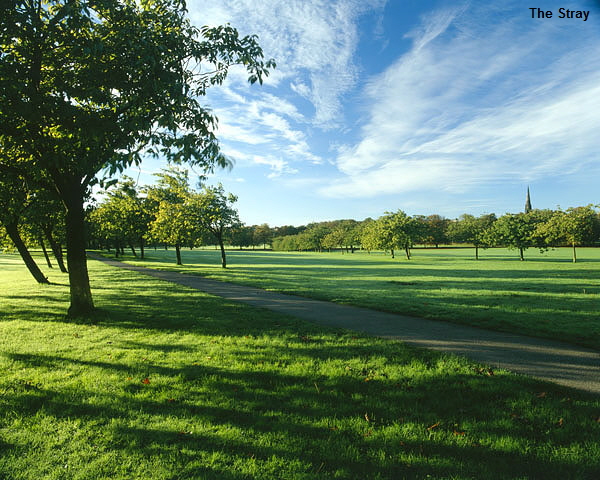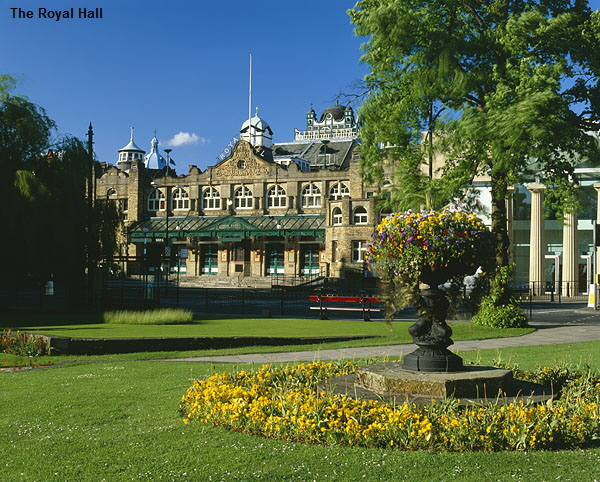|
Health and Hospitality
Craig Roberts explores the spa town of Harrogate in North Yorkshire.
Sitting neatly between the landscape splendour of the Yorkshire Moors and the Yorkshire Dales is the elegant and historic town of Harrogate. Made up of the villages of High and Low Harrogate, its history lies around its unique collection of Mineral Wells that made it the original ‘Spa Town’, even before the older and equally well known resort of Bath.
The name Harrogate is of Anglo-Norse origin meaning either ‘the road to Harlow’ (another Anglo-Norse name found all over England meaning ‘Soldier’s Hill’) or ‘the road to Haverah’. Harlow Hill is Harrogate’s highest point and Haverah was the name of a royal hunting ground that was part of the Royal Forest of Knaresborough, part of which now forms The Stray, a great expanse of greenery known as the World’s Biggest Lawn.
It was here on The Stray in 1571, that William Slingsby of nearby Bilton Hall discovered the Tewit Well (tewit being a northern name for the Lapwing, which Slingsby had found in great numbers around the area). He came across the freshwater spring while out riding and found its qualities were similar to those he had tried at Spa in Belgium. Brought to the attention of the medical profession, it was noted in Dr. Edmund Deane’s Spadacrene Angelica or ‘The English Spa’ in 1626 and thus its medicinal properties became famous and it wasn’t long before people flocked to the area because of it, which prompted the growth of the town. A second well was discovered close by in 1631 called St. John’s Well and by the mid 17th century a number of hotels were built to accommodate the many visitors. With a church, theatre and the first shops beginning to open as well, High Harrogate became a fashionable place in ‘Season’.
 |
Not to be out done though, by the late 1600’s Low Harrogate, always seen as socially inferior to its counterpart used its newly discovered sulphur springs (High Harrogate’s springs were iron only) as the new trend in healing waters. Thus the tables were turned and this saw the development of the once overshadowed village that now makes up the main part of the town.
At the centre of Low Harrogate is the elegant Royal Pump Room. An octagonal shaped, domed building built in 1842, housed over the Old Sulphur Well, the strongest of Harrogate’s wells and in-fact the strongest in Europe. Now a fascinating museum to the history of this spa town, this well was once known as ‘The Stinking Spaw’ and if you care to sample the water you’ll realise why! Opposite the pump room is Hales Bar, a superb example of an early Victorian public house containing many original features including gas lighting.
Just along from here in Swan Road is the Mercer Art Gallery. This building was originally the Promenade Inn, opened in 1806, it was used as a meeting place for themany visitors to the wells to relax after taking the waters. Over the years this building has taken on many personas including the Town Hall, a theatre were famous names such as Oscar Wilde and Lillie Lanngtry have performed, and from 1991 as an art gallery providing a permanent exhibition to Harrogate’s fine art and antiquities.
Just around the corner are the Crescent Gardens, which were very much the epicentre of Harrogate in its heyday. Its here that The Royal Baths were opened in 1897 by the newly appointed Municipal Council to ensure Harrogate was the foremost place for hydrotherapy treatments. These ranged from Turkish Baths to poultices of hot mud and it wasn’t long before they were acclaimed worldwide. The interior was lavishiouly decorated throughout with ornate tiling and fittings and impressive columns supporting the domed roof. At the moment the whole complex is being redesigned to include a new spa centre plus high-class restaurants and wine bars.
 |
Opposite the baths in the former building of the New Victoria Baths are the Council’s Municipal Buildings. Adjacent to this across the Ripon Road is Harrogate’s principal exhibition, conference and entertainment buildings. The contemporary looks of the Conference Centre are in direct contrast to the grand appearance of the Royal Hall. Opened in 1903 as the Kursaal (a German term for a spa assembly hall and changed to the Royal Hall after the war), its beautiful interior has seen the likes of Laurel and Hardy, the Beatles and Elgar perform here. Next to this once stood the Royal Spa Concert Rooms, built in 1835 it was Harrogate’s finest spa building, classically designed as a Doric Temple with stone columns it was Low Harrogate’s principal assembly room and it was from here in 1858 that Charles Dickens gave a famous reading.
At the centre of Crescent Gardens themselves is the statue of Cupid and Psyche housed in a glass dome. Carved from marble in 1861 by Italian sculpture Giovanni Maria Benzoni it originally stood in the gardens of the Spa Concert Rooms. When the gardens were removed the statue was ‘lost’ in storage before being rediscovered in 1989.
Another area of greenery that Harrogate is renowned for is Valley Gardens. Formed in a natural dell these gardens started off as a simple pathway from the Old Sulphur Well. This path is now known as Elgar Walk in honour of the British composer’s many visits to the town. It leads to the heart of the gardens, an area once known as Bogs Field. Totally unique, in that it contains no less than 36 different types of mineral wells which were piped down to the Royal Baths. Here you can also find the Magnesia Well café, an attractive circular domed building, providing the perfect setting to enjoy a summers day. On the other side of the gardens is the Sun Colonnade opened in1933 by physician Lord Horder to provide a covered walkway to the Sun Pavilion and onto the Royal Pump Room. The entire gardens were enlarged to their present size in 1901 and from 1947 to 1996 was the venue for the Spring Flower Show, before being moved to the Great Yorkshire Showground.
At the top of Montpellier Parade, overlooked by the War Memorial is Betty’s Café. This institution of Harrogate is famed for its marvellous teas and cakes, which have been enjoyed by amongst others James Alfred Wight, better known as James Herriot, an institute of Yorkshire himself. The parade itself is typically Victorian, built in the 1860’s by George Dawson. Also included amongst the elegant shops is Farrah’s Harrogate Toffee Shop, makers of Harrogate Toffee since 1840 and still made to it’s the original recipe, which includes lemon oil to take away the taste of some of the stronger spa waters!
Across the road from Farrah’s you’ll see the majestic looking Crown Hotel. It was here that Lord Byron stayed in 1806. A plaque outside commemorates his visit.
In nearby Swan Road is another grand hotel, the Old Swan. During the 1700’s this was used by the many visitors to the spas, and was also the choice of another famous visitor to the town. It was here that the missing Agatha Christie was discovered in 1926. Overwork and the discovery that her husband was having an affair had induced a breakdown and after seeing poster at Waterloo Station advertising Harrogate she decided to hide away here. After a great deal of speculation in the press and one of the biggest manhunts in history she was found in the hotel staying under a false name. The saga became the subject of the film ‘Agatha’ made on location here in 1977.
The town also holds the annual Great Yorkshire Show. This wonderful pageant of country life held each year in July attracts more than 100,000 visitors. They come to see more than 8,000 different animals, displays of the latest farming technologies, all manner of country pursuits as well as traditional skills like dry stone walling. All these exhibits surround the Main Ring, which enthrals the audience with marching bands and international show jumping.
Today Harrogate has grown and flourished with the times to include a modern shopping centre but amongst the new still remains the old. Fattorini on Parliament Street is Harrogate’s oldest jeweller established in 1831 and was originally situated in High Harrogate. Leading off Parliament Street is the Ginnel, which once formed part of the footpath between Low and High Harrogate. This features the Harrogate Antique centre, an antique market featuring dozens of small shops. Also off Parliament Street in James Street, are another old jewellers, Ogdens. With its delightful Edwardian façade this family owned business has supplied Winston Churchill amongst others.
The latest edition to the retail area is the Victoria Shopping Centre. Thoroughly modern inside, its architect has designed a elegant building, with a façade inspired by Palladio’s Basilica at Vicenza, that while offering the needs of present times keeps in faith with Harrogate’s original architects.
This cosmopolitan town has not lost any of its charm and its history has been well preserved over the years, making it a town full of discoveries with a unique insight into the development of the spa.
All images and text copyright © Craig Roberts 2001
|